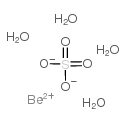Beryllium-stimulated reactive oxygen species and macrophage apoptosis.
Richard T Sawyer, David R Dobis, Mark Goldstein, Leonard Velsor, Lisa A Maier, Andrew P Fontenot, Lori Silveira, Lee S Newman, Brian J Day
Index: Free Radic. Biol. Med. 38(7) , 928-37, (2005)
Full Text: HTML
Abstract
Beryllium (Be), the etiologic agent of chronic beryllium disease, is a toxic metal that induces apoptosis in human alveolar macrophages. We tested the hypothesis that Be stimulates the formation of reactive oxygen species (ROS) which plays a role in Be-induced macrophage apoptosis. Mouse macrophages were exposed to 100 microM BeSO4 in the absence and presence of the catalytic antioxidant MnTBAP (100 microM). Apoptosis was measured as the percentage of TUNEL+ and caspase-8+ cells. ROS production was measured by flow cytometry using the fluorescence probes, dihydroethidine (DHE) and dichlorofluorescein diacetate (DCFH-DA). Be-exposed macrophages had increased TUNEL+ cells (15+/-1% versus controls 1+/-0.2%, P<0.05) and increased caspase-8+ cells (18.7+/-2% versus controls 1.8+/-0.4%, P<0.05). Be-induced caspase-8 activation, and a 4-fold increase in ROS formation, was ameliorated by exposure to MnTBAP. Hydrogen peroxide (30 microM) exposure potentiated Be-induced caspase-8 activation, and was also attenuated by MnTBAP. Our data are the first to demonstrate that Be stimulates macrophage ROS formation which plays an important role in Be-induced macrophage apoptosis.
Related Compounds
| Structure | Name/CAS No. | Molecular Formula | Articles |
|---|---|---|---|
 |
beryllium sulfate tetrahydrate
CAS:7787-56-6 |
BeH8O8S |
|
[Diagnosis of chronic berylliosis].
1999-04-01 [Pneumologie 53(4) , 193-8, (1999)] |
|
Beryllium-stimulated release of tumor necrosis factor-alpha,...
1997-12-01 [Am. J. Respir. Crit. Care Med. 156(6) , 1884-91, (1997)] |
|
Target organ localization of memory CD4(+) T cells in patien...
2002-11-01 [J. Clin. Invest. 110(10) , 1473-82, (2002)] |
|
Beryllium presentation to CD4+ T cells underlies disease-sus...
2000-11-07 [Proc. Natl. Acad. Sci. U. S. A. 97(23) , 12717-22, (2000)] |
|
Divergent effect of cobalt and beryllium salts on the fate o...
2011-02-01 [Toxicol. Sci. 119(2) , 257-69, (2011)] |